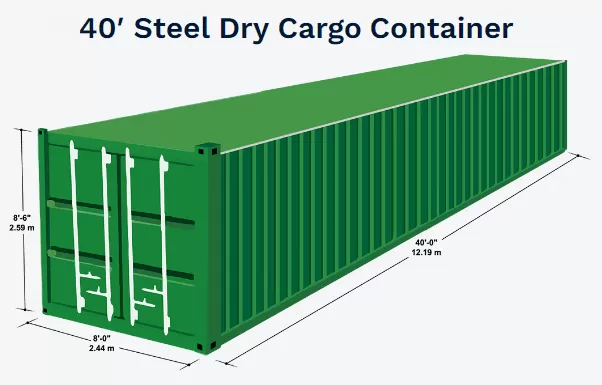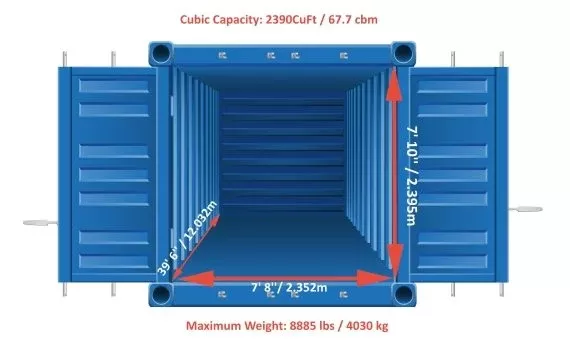If you're asking, "How much does a 40-foot container weigh?" you're really asking, "How much can I load into it?" This definitive guide provides not just the numbers, but the deep operational knowledge you need to plan your shipping efficiently, safely, and cost-effectively.
Part 1: The Quick Answer—Container Weights at a Glance
Here is the definitive breakdown of weights for a standard 40-foot dry container. (Specialized types are detailed in Part 3).
| Weight Type |
Abbreviation |
Meaning |
Standard 40' Dry |
40' High-Cube (HC) |
| Tare Weight |
TARE |
The empty container's weight |
3,750 kg (8,270 lbs) |
3,900 kg (8,600 lbs) |
| Payload Capacity |
- |
The MAX weight of cargo you can load |
27,230 kg (60,030 lbs) |
28,600 kg (63,030 lbs) |
| Maximum Gross Weight |
MGW |
The total weight of the container and cargo |
30,480 kg (67,200 lbs) |
32,500 kg (71,650 lbs) |
Key Takeaway: Your cargo weight cannot exceed the Payload Capacity. The most common limit enforced globally is 30,480 kg (67,200 lbs) for gross weight, but always check with your carrier first.
Part 2: Visualizing Your Container's Capacity
It's not just about weight; it's about space. A 40 ft container's internal dimensions determine how you pack it.
Standard 40' (DV): ~67.7 m³ (2,390 cu ft) of space
40' High-Cube (HC): ~76.3 m³ (2,695 cu ft) of space (About 12.7% more space)
*(Insert a high-quality, labeled diagram of a 40ft container here showing internal dimensions (LxWxH), door opening size, and the relative concepts of Tare, Payload, and Gross Weight.)*
Part 3: Beyond the Standard: Weights of Specialized 40ft Containers
(Leveraging Aztec's strength in detailed specs)
The standard box is just the beginning. Different goods require different containers, each with unique weights:
Reefer Container (40'RH): Tare Weight: ~4,500 kg (9,920 lbs). Heavier due to the integral refrigeration unit.
Flat Rack Container: Tare Weight: ~5,200 kg (11,460 lbs). Built with strengthened framing for heavy, oversized cargo.
Open Top Container: Tare Weight: ~4,100 kg (9,040 lbs). Features a convertible top for top-loading cargo.
Pro Tip: Always use the actual tare weight printed on the container's door for precise calculations, especially for specialized equipment, as weights can vary by manufacturer and age.
Part 4: The Operational Impact: Why Weight is Everything
(Incorporating iContainers' practical, risk-based advice)
Misunderstanding container weights leads to three critical problems:
Safety Risks: Overloaded containers are a major hazard. They can collapse in stacks onboard ships, shift during transport, and cause truck accidents.
Financial Penalties: "Weighbridge Surcharges" are common. If your container is overweight at the port, you will face steep fines, costly delays, and the nightmare of last-minute re-handling or off-loading.
Logistical Nightmares: Overweight containers may be refused loading entirely, disrupting your entire supply chain and leading to stockouts.
How to Calculate Your Allowable Cargo Weight:
Payload = Maximum Gross Weight - Tare Weight
Example: For a standard container:27,230 kg = 30,480 kg - 3,750 kg
Part 5: Strategic Considerations for Shippers
(Expanding on Freightos's comprehensive approach)
Your choice of container influences more than just weight.
Cost Factor: Ocean freight is rarely charged purely by weight. It's usually based on the container type (standard vs. reefer) and whether you're paying for a Full Container Load (FCL) or sharing space via Less than Container Load (LCL). However, exceeding weight limits will always incur extra charges.
The "Cube is Full" Dilemma: Often, especially with lightweight but voluminous goods (e.g., pillows, plasticware), you will fill the space (cube out) long before you hit the weight limit. Conversely, with dense products (e.g., machinery, metal parts), you will hit the weight limit (weigh out) with plenty of space left over.
Summary & Key Recommendations
| Question |
Answer & Action Item |
| What's the empty weight? |
~3,750 kg (8,270 lbs). Check the door of your specific container for the exact tare weight. |
| What's the max cargo weight? |
~27,230 kg (60,030 lbs). Never exceed this. Confirm the gross weight limit with your freight forwarder. |
| Standard or High-Cube? |
Need to ship light, bulky items? Choose a 40'HC for 12% more space at a minimal extra cost. |
| What's the #1 rule? |
Know your cargo's exact weight and volume before booking. Communicate clearly with your logistics partner. |
Still have questions? Our container weight and capacity are complex, but your logistics don't have to be. Get a free, customized quote today, and our experts will ensure your shipment is optimized for weight, cost, and safety.
Frequently Asked Questions (FAQ)
1. Do all carriers enforce the same weight limits for 40 ft containers?
No. While the ISO standard allows a 30,480 kg (67,200 lb) gross weight, some carriers, ports, or inland trucking companies may set stricter limits based on road weight restrictions. Always confirm with your freight forwarder.
2. Can I load beyond the maximum gross weight if my container has space?
No. Even if you have space, exceeding the weight limit is illegal and unsafe. Your container may be rejected at port or fined at weighbridges.
3. Is a high-cube container always better than a standard 40 ft?
Not always. A high cube adds 12% more volume but also has slightly more tare weight. If your cargo is dense and heavy, you may not benefit from the extra height.
4. What’s the difference between payload and chargeable weight?
Payload refers to how much cargo weight the container can physically carry. Chargeable weight applies in air freight or LCL shipments, where billing may depend on volume or dimensional weight.
5. How do I check the tare weight of my specific container?
Look at the container door—the manufacturer’s plate shows Tare Weight, Payload, and Maximum Gross Weight. Always use this actual data, not estimates.
6. Can overweight cargo be repacked at the port?
Yes, but it’s costly and time-consuming. You’ll need to offload cargo, arrange alternative transport, and pay for handling fees. Prevention is far cheaper.
7. What happens if my container is underweight?
There’s no penalty for shipping a partially filled or light container, but you’ll still pay the same FCL rate. To save costs, consider LCL if your volume is well below full capacity.
8. How do container weight rules affect inland trucking in the U.S.?
U.S. road limits are often stricter than maritime ones. A container legally loaded on a ship might still be overweight for local trucking. Your forwarder can arrange tri-axle chassis or overweight permits if needed.
9. Can I request special containers for unusual cargo?
Yes. Options like flat racks or open tops are designed for oversized or heavy cargo. Just note they come with higher tare weights and often higher freight costs.
10. What’s the single best practice for avoiding weight issues?
Weigh and measure your cargo at origin before packing. Share accurate weight, CBM, and HS codes with your forwarder so they can book the right equipment and avoid last-minute surprises.

 EN
EN
 FR
FR
 ES
ES
 JA
JA
 PT
PT
 RU
RU
 AR
AR






